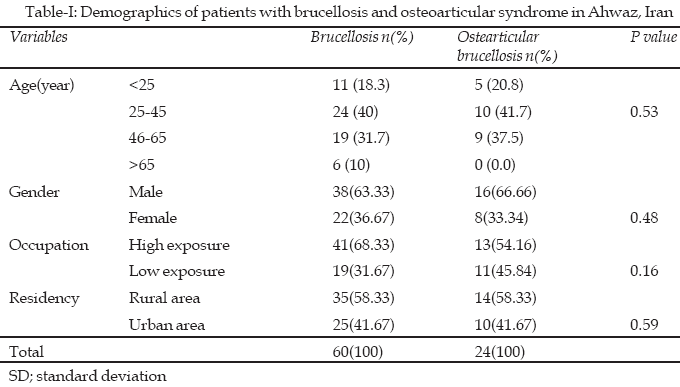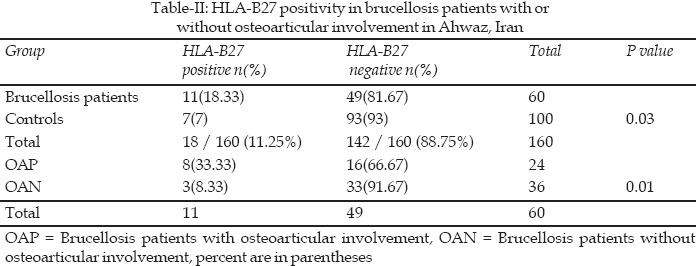|
|
||||
|
Published by : PROFESSIONAL MEDICAL PUBLICATIONS |
||||
|
ISSN 1681-715X |
||||
|
||||
|
- |
||||
|
ORIGINAL ARTICLE |
||||
|
- |
||||
|
Volume 25 |
April - June 2009 (Part-I) |
Number 2 |
||
|
|
||||
|
|
||||
|
|
||||
|
Published by : PROFESSIONAL MEDICAL PUBLICATIONS |
||||
|
ISSN 1681-715X |
||||
|
||||
|
- |
||||
|
ORIGINAL ARTICLE |
||||
|
- |
||||
|
Volume 25 |
April - June 2009 (Part-I) |
Number 2 |
||
|
|
||||
|
|
||||
Frequency of HLA-B27 antigen in Iranian patients
with brucellosis and it’s relationship with
osteoarticular complication
Seyed Mohammad Alavi1, Mohammad Said Seraj2,
Arash Etemadi3, Moradzadegan H4
ABSRACT
Objectives: To determine frequency of HLA-B27 in brucellosis patients and to investigate a possible association between osteoarticular brucellosis and HLA-B27 antigen.
Methodology: Sixty patients with serologically confirmed brucellosis and 100 healthy controls were screened for HLA-B27 by using standard microlymphocytotoxicity method. Osteoarticular involvement was suggested by clinical presentation and confirmed by nuclear scan. Patients were placed in two groups and compared, patients with osteoarticular involvement (OAP group) and without osteoarticular involvement (OAN group). All data were analyzed by SPSS (version11.5, USA) and using Fisher’s exact X2 test.
Results: Out of total 60 patients with brucellosis 38(63.3%) were male. Mean age of the patients were 36.2±12.3 with the range of 18-65 years. HLA-B27 test was positive in 11 patients (18.33%) with brucellosis, whereas in control group HLA-B27 positivity was 7% (p<0.05).The prevalence of HLA-B27 in OAP and OAN groups was 33.33% and 8.33%, respectively (p<0.05).
Conclusions: The prevalence of HLA-B27 in our brucellosis patients is higher than normal population and there is a significant association between HLA-B27 and brucellar osteoarthritis in the region of study.
KEYWORDS: Brucellosis, Osteoarticular involvement, HLA-B27, Ahwaz.
Pak J Med Sci April - June 2009 Vol. 25 No. 2 253-256
How to cite this article:
Alavi SM, Seraj MS, Etemadi A, Moradzadegan H. Frequency of HLA-B27 antigen in Iranian patients with brucellosis and it’s relationship with osteoarticular complication. Pak J Med Sci 2009;25(2):253-256.
1. Dr. Seyed Mohammad Alavi, MD
Associated Professor of Medical College
2. Dr. Mohammad Said Seraj, MD
Rheumatology Department, Golestan Hospital
3. Dr. Arash Etemadi, MD
4. Dr. Moradzadegan, MD
Pasteur laboratory
1: Infectious and Tropical Diseases Resaerch Center,
Infectious Disease Ward,
Joundishapour University of Medical Sciences,
Ahwaz,Iran,
Correspondence:
Dr. Seyed Mohammad Alavi,
No: 52, West 11 Avenue, Kianabad, Ahwaz, Iran.
Email: alavi1329dr@yahoo.com
* Received for Publication: April 3, 2008
* Accepted: January 22, 2009
INTRODUCTION
Brucellosis is a zoonosis that produces severe morbidity in humans, and, is still of both health and economic significance in many developing countries.
1 The disease exists worldwide, especially in the Mediterranean basin, the Arabian Peninsula, the Indian subcontinent, in parts of Mexico and Central and South America.2 The prevalence of brucellosis is 60 to 80/100,000 in Mediterranean and most Middle Eastern countries. Iran has a disease incidence of 132/100000.3,4 Among the clinical manifestations of brucellosis, arthritis may occur in over one-third of the patients.2 Different articular syndromes have been well recognized: some are definitely infectious in nature, whereas others appear to be reactive.5The possibility that B27 antigens could predispose to the occurrence of brucellar spondyloarthritis was investigated in previous studies with controversial results. Hodinka et al reported a positive relationship between possession of HLA-B27 and spondyloarthritis in chronic brucellosis .However, Alarcon et al found no increased incidence of any HLA type in their patients with acute brucellosis induced arthritis compared with cases of brucellosis without arthritis.
5,6 Ertema et al7 reported that although HLA-B27 frequency in brucellosis patients with osteoarticular involvement was slightly higher than patients without osteoarticular involvement, but, there was no significant difference (p >0.05). Because of high prevalence of brucellosis cases in Iran and as no published Iranian study of HLA antigens in brucellosis case could be found, we decided to conduct the study.The aim of the present study was to determine frequency of HLA-B27 in brucellosis patients and to investigate a possible association between osteoarticular involvement of brucellosis and HLA-B27 antigen.
METHODOLOGY
This prospective analytic descriptive study was carried out in 60 patients, in infectious diseases ward of Razi Hospital in Ahwaz south west Iran, during 2003-2006. Following inclusion criteria for brucellosis were considered 1) Clinical features 2) Positive serology according to Iranian national program against brucellosis (Wright 1:80 or more, two mercaptoethanole (2ME) 1:40 or more, Comb’s Wright >1:80) or positive blood or bone marrow cultures. Inclusion criteria for definite diagnosis of osteoarticular involvement were 1) Clinical features, not explained by other diseases, 2) abnormal nuclear bone scan. Standard microlymphocytotoxicity technique method was used for detection of HLA-B27 antigen in 60 patients with brucellosis and 100 healthy controls (normal blood donors). A questionnaire including characteristic demographic and brucellosis related factors were used to collect data. Patients with brucellosis were placed in two groups and compared with each other. Patients with osteoarticular involvement as OAP group and patients without osteoarticular involvement as OAN group. All data were analyzed by SPSS (version11.5, USA) and using Fisher’s exact X2 test.
RESULTS
Out of total 60 patients with brucellosis 38(63.3%) were male and 22(36.7%) were female. Mean age of the patients were 36.2±12.3 (mean ± SD) years with the range of 18-65 years. Demographic data in brucellosis patients and osteoarticular involvement are shown in Table-I.

There was no significant difference in age, gender, residency and risk of occupational exposure between two groups (p>0.05). HLA-B27 test was positive in 11 patients (18.33%) with brucellosis, whereas in control group HLA-B27 positivity was 7%. The results of HLA-B27 test in patients with and without osteoarticular involvement are shown in Table-II. The overall prevalence of HLA-B27 in the study population (160 subjects 60 with brucellosis & 100 controls) was 11.25%. There was significant difference in HLA-B27 positivity between two groups (p<0.05) and between brucellosis patients and controls (p<0.05).

DISCUSSION
Brucellosis like other chronic inflammatory conditions such as ankylosing spondylitis is associated with HLA B27. But the association is not absolute.
8 In the present study the prevalence of HLA-B27 in brucellosis patients was higher than normal population (blood donor as control group), with the rate of 18.33% vs. 7%, respectively. This finding is consistent with some previous studies6,7,9 but, also in consistent with other studies.5,10 Paeja et al, in their work did not find an HLA-B27 increase in the group of patients with brucellosis associated spond-ylarthritis when compared with healthy individuals.10 Alarcon, et al reported that. HLA-B27 frequency was diminished in the Peruvian brucellosis patients. The most interesting finding was the presence of a statistically significant low frequency of HLA-A2 in the disease group suggesting that this antigen may play a protective role for the development of brucellosis.5 We believe that geographical differences, difference in strain of Brucella (Abortus vs. Melitensis) and genetic factors other than HLA-B27 may play a role in these differences. Dawes et al, reported that B.aborus is different of B.melitensis in relation to HLA antigens.9Our study revealed significant association between HLA-B27 and osteoarticular involvement in brucellosis patients. This finding is similar to only with few previous studies.
6 Most of the published studies discarded a significant association between HLA-B27 and osteoarticular brucellosis.5,7,9,10 The reason for this finding is not clear for us but, chronic illness in our osteoarticular patients (most of them had positive two ME suggesting brucellosis with more than one year duration) may be responsible for this difference.ACKNOWLEDGMENT
The authors wish to thank the chief and personnel of Jondishapoor Infectious and Tropical Research Center for supporting of this study. We also acknowledge the chief and personnel of the infectious disease department of Razi hospital for their kind assistance.
Conflict of interest: There is no conflict of interest.
REFERENCES
1. Matyas Z, Fujikura T. Brucellosis as a world problem. Dev Bio Stand 1984;56:3-20.
2. Young EJ. Brucella species. In: Mandel GI, Bonnet JE, Dolin R. (edts). Principle and practice of infectious disease. 6th ed. New York. Churchill Livingstone 2005;2669-74.
3. Wright SG. Brucellosis. In: Hunter’s Tropical Medicine and Emerging Infectious Disease, 8th ed. Philadelphia: WB Saunders; 2000;416-20.
4. Capasso L. Bacteria in two-millennia-old cheese and related epizoonoses in Roman populations. J Infect 2002;45(2):122-7.
5. Alarcón GS, Gotuzzo E, Hinostroza SA, Carrillo C, Bocanegra TS, Espinoza LR. HLA studies in brucellar spondylitis. Clin Rheumatol 1985;4(3):312-4.
6. Hodkina L, Gomor B, Meretey K. HLA-B27 associated with spondyloarthritis in chronic brucellosis. Lancet 1978;1:499-502.
7. Ertem GT, Tanyel E, Tulek N, Ulkar GB, Doganci L. Osteoarticular involvement of brucellosis and HLA-B27 antigen frequency in Turkish patients. Diagn Microbiol Infect Dis 2004;48(4):243-5.
8. Madhavan R, Parthiban M, Rajendran CP, Chandrasekaran AN, Zake L, Sanjeevi CB. HLA class I and class II association with ankylosing spondylitis in a southern Indian population. Ann N Y Acad Sci 2002;958:403-7.
9. Dawes PT, Ghosh SK. Tissue typing in brucellosis. Ann Rheum Dis 1985;44(8):526-8.
10. Pareja E, Bonal FJ, Paule P, Salvatierra D, Garrido F. HLA antigens in brucellosis. Exp Clin Immunogenet 1985;2(1):1-3.
HOME | SEARCH | CURRENT ISSUE | PAST ISSUES
Professional
Medical Publications
Room No. 522, 5th Floor, Panorama Centre
Building No. 2, P.O. Box 8766, Saddar, Karachi - Pakistan.
Phones : 5688791, 5689285 Fax : 5689860
pjms@pjms.com.pk